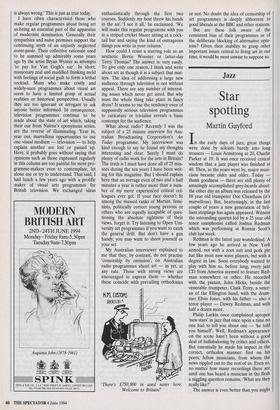Jazz
Star spotting
Martin Gayford
In the early days of jazz, great things were done by soloists barely into long trousers — Louis Armstrong at 20, Charlie Parker at 19. It was once received critical wisdom that a jazz player was finished at 40. Then, as the years went by, major musi- cians became older and older. Today thank goodness — there are still plenty of amazingly accomplished grey-beards about: the other day an album was released by the 88 year old trumpeter Doc Cheatham (it's marvellous). But, hearteningly, in the last couple of years a new generation of bril- liant striplings has again appeared. Witness the astounding quartet led by a 25 year old tenor saxophonist called Joshua Redman which was performing at Ronnie Scott's club last week.
Redman is the latest jazz wunderkind. A few years ago he arrived in New York armed, not with a zoot suit and pork pie hat like most new wave players, but with a degree in law. Soon everybody wanted to play with him so, before long, every jazz CD from America seemed to feature Red- man somewhere or other. He recorded with the pianist, John Hicks, beside the venerable trumpeter, Clark Terry, a veter- an of the Ellington band, with the drum- mer Elvin Jones, with his father — also a tenor player — Dewey Redman, and with half a dozen more.
Philip Larkin once complained apropos `new stars' in jazz that once upon a time no one had to tell you about one — 'he told you himself . Well, Redman's appearance on the scene hasn't been without a good deal of hullabalooing by critics and others. But essentially he made his impact in the correct, orthodox manner: first on his peers, fellow musicians, from whom the news rippled out to the rest of us. Even so, no matter how many recordings there are until one has heard a musician in the flesh a niggling question remains, 'What are they really like?' The answer is even better than you might have expected. A combination of over- rehearsing and technological gloss contrives to make almost everybody sound tame and muted on recordings these days. Live, it can be a different matter — and it certainly is with Redman. The albums show him to be highly accomplished, with a love- ly deep, blue sound in the style of past masters of the tenor saxophone like Dexter Gordon or Ben Webster. But they do not prepare you for the whirlwind energy of his performance in person, nor for the shame- less showmanship with which he whips almost every solo up to a screaming climax.
Most important, from the first note he played, Redman showed the absolute, almost arrogant, authority which is the mark of a major jazz soloist. He is obviously the real thing. Nor is he a one- off. The whole band is remarkable. Eric Reed, the pianist, had already introduced himself to British audiences with a barn- storming, rocking gospel passage with which he broke up the Albert Hall last summer when he appeared with Wynton Marsalis. The drummer, Brian Blade, an unknown name, turned out to have panache and razor-sharp timing of a great percussionist.
While Christian McBride scarcely out of his teens — is a rara avis among bassists. For 25 years virtually all jazz bassists have used a pick-up microphone and amplifier which distorts the sound of the instrument — producing a high plinking tone. McBride dispenses with those props, and consequently gets a true, deep enormous bass sound — boom, whump, barn. Fur- thermore, unlike most others, he plays interesting improvisations. Normally, as Duke Ellington once remarked, bass solos come round like advertisements on television, and one's reaction is similar, mentally to make a cup of tea. McBride's solos you actually look forward to. There is no higher praise.
One large question mark hangs over the newest jazz generation. Are they original enough to be authentic? Writing in 1966 Larkin pointed out that the reaction to a `new star' was already not 'How is he new?' but 'How can he be new?' And that still holds. There are — it seems — no rhyth- mic or harmonic experiments that remain to be made. The problem is to find a personal voice within an idiom which has already broadly marked out. Thus Redman can draw on the inventions of dozens of great tenor players — Lester Young, Sonny Rollins, John Coltrane — but is then faced with the problem of sounding like himself. Even so, he seems to be pulling it off — he certainly doesn't sound like a weak copy of someone else. And there is, if not a new style, at least a new mood in a lot of these fledgling musicians of the Nineties — a sort of wild energy that has got into the music. Suddenly, unexpectedly, the future of jazz looks bright and hopeful.



























































 Previous page
Previous page